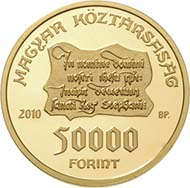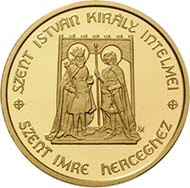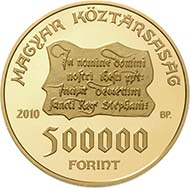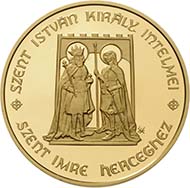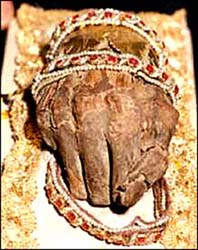August 20, 2010 – On August 20, 2010 Hungary will issue two new commemorative gold coins on the admonishments of king St. Stephen to his son St. Emeric.
Commemorative Coin “Admonishments of King St.Stephen to his Son, St.Emeric” – Fineness: Au .986; Face value: 50.000 HUF; diameter: 22 mm; Weight: 6,982 g (= 2 ducats); Mintage: 5.000 in Proof; Designer: Eniko Szollossy.
The gold commemorative coin minted in celebration of St. Stephen’s Admonitions was created by the sculptor Eniko Szollossy and is to be issued by the Magyar Nemzeti Bank in two denominations and sizes. The front of the coin shows the handwritten Latin introduction to the Admonitions: “In nomine Domini nostri Ihesu Christi: Incipit Decretum sancti Regis Stephani:” (Thuróczy Chronicle, 15th century).
Commemorative Coin “Admonishments of King St.Stephen to his Son, St.Emeric”- Fineness: Au .986; Face value: 500.000 HUF; diameter: 46 mm; Weight: 62,838 g (= 16 ducats); Mintage: 500 in Proof; Designer: Eniko Szollossy.
The contemporary method of description is reinforced by the use of the Lombard font for the legends on the coin. The back of the coin was inspired by the 15th century altar picture of Saint Stephen and Saint Emeric from St. Stephen’s church in Mateóc (Matejovce, part of the town of Poprád, in present-day Slovakia).
Saint Stephen’s Admonitions to his son Saint Emeric
Anonymus, a chronicler at the end of the 12th century, wrote that upon settling in the Carpathian Basin Prince Árpád and his nobles “established the traditional laws of the country”. This would have been the Hungarian state’s first collection of laws, but it was not set down in writing. One century later, Prince Árpád’s descendant, Vajk, who was christened Stephen, was crowned king of Hungary.
Statue of king Stephen at the Fischerbastei. Photo: Ben Godfrey / Wikipedia.
Numerous written records exist of the institutions, actions and laws of the kingdom. These laws were preserved along with a work on the theory of statehood known as the “Admonitions”, which was written around 1010 by the first Hungarian king, St. Stephen, to his designated heir, Prince St. Emeric (Imre). Looking at King Stephen’s laws and especially at the Admonitions, it is striking that the leadership of the kingdom was based on the ancient traditions, habits and customs, even though the creation of the kingdom had resulted in significant changes.
The Admonitions are similar to the “Mirrors” of that day and age, a medieval genre, which instructs rulers how to be good, just, wise and strong kings. The writer was probably a well-educated member of the clergy, but the mood of the work (e.g. the salutation “Dear Son”) and unique expressions indicate that there may be some truth to the legends of the 11th and 12th centuries, according to which the king himself took part in writing it. As Bishop Hartvik wrote in 1115, “Driven by his fatherly love, he himself wrote a pamphlet on moral teachings, in which he spoke in a frank and friendly manner, with words of spiritual advice.”
King Stephen’s right hand. Photo: Cserlajos / Wikipedia.
St. Stephen’s Admonitions underline the importance of the church (preservation of the faith, the solidity of church structures, respect for the prelates, regular prayer), as well as emphasizing respect for leaders and soldiers and the role of councilors (“council makes a king a king, defines the borders of the country, defends the homeland, names friends, hence choose councilors who are more clever and popular than average…”), the importance of impartial action (“if you wish to uphold your dignity as king, insist on impartiality”) and advises to show hospitality to guests (“take them into your care”). Admonitions use an analogy to explain that Hungarians must be governed in accordance with Hungarian customs: “What Greek could rule over the Latins according to Greek custom, and what Latin could rule the Greeks in accordance with Latin custom? Not one.”
Written a thousand years ago, the Admonitions is a significant part of Hungary’s heritage. More than just a thousand year-old document, its contents and advice are a shining example of our Hungarian spirit and our place in Europe.
Written by: Dr. István Gedai
In order to find out more about Hungarian commemorative coins, please click here.




